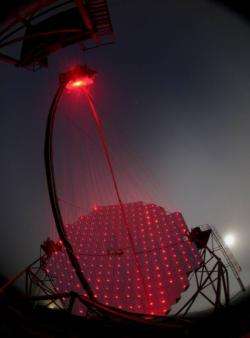MAGIC discovers variable very high energy gamma-ray emission from a microquasar

In a recent issue of Science, the Major Atmospheric Gamma-ray Imaging Cherenkov (MAGIC) Telescope has reported the discovery of variable very high energy (VHE) gamma-ray emission from a microquasar. Microquasars are binary star systems, composed of a massive ordinary star and a compact object, which can be either a neutron star or a black hole.
The stars orbit around one another and, when they are close enough, there is a transfer of matter from the massive one toward the compact object, due to gravitational attraction. This matter forms a disk around the compact object and is heated-up due to viscosity, producing X-rays. In addition, the collapse of matter from the disk into the compact object produces the ejection of jets of particles that travel in opposite directions at velocities close to the speed of light. In particular the jets contain electrons that undergo the so-called synchrotron radiation, which can be detected by radio telescopes.

These jets remain among the most spectacular, yet poorly explained astrophysical phenomena. Microquasars can be considered as scaled-down versions of active galactic nuclei, or quasars. Quasars display also jets of relativistic particles, but in their case the compact object is a black hole of millions of solar masses located at the center of a galaxy. In contrast to quasars, where phenomena of jet formation and matter ejection can take years, microquasar jets evolve in time scales of days, a fact that makes them more suitable for human observations. Microquasars are also candidates to be one of the sites of production of the cosmic rays, a mystery unsolved since their discovery almosta hundred years ago.
The study of microquasars represents one of the most important additions to the recently born field of VHE gamma-ray astrophysics. VHE gamma-rays are a kind of radiation which is produced in the most violent phenomena of our Universe, like e.g. supernova explosions or quasars. They can reach the Earth, albeit at a very low rate (typically less than one gamma-ray per square meter and per week). MAGIC detects gamma-rays through the short light flashes that they produce as they enter the atmosphere.
MAGIC is the largest telescope exploiting this experimental technique, with a 17 m diameter mirror. It is located at the observatory Roque de los Muchachos on the Canary Island of La Palma (Spain). The MAGIC team is composed of more than 130 scientists coming from 9 countries, namely: Spain, Germany, Italy, Switzerland, Poland, Armenia, Finland, Bulgaria and USA.
MAGIC has observed, between October 2005 and March 2006, one of the approximately 20 known microquasars, called LS I +61 303. VHE gamma-rays coming from LS I +61 303 have been detected at an approximate rate of one gamma-ray per square meter and per month. Only one other binary star system (LS 5039) is known to emit VHE gamma-rays.
This new discovery points to the fact that gamma-ray production could be a common property of microquasars. The results of the MAGIC team have revealed a very interesting property: the intensity of the gamma-ray emission coming from LS I +61 303 varies with time. The binary system was observed at different 2 moments along the orbital cycle of the compact object around the massive star. The time scale of variability was similar to the orbital period, showing that the VHE emission is directly related to the interplay between the two stars of the system.
Furthermore, some theorists expected the gamma-ray emission to happen when the two stars are closest to one another (i.e. at periastron passage) since it is at this moment when the particles accelerated in the jet find the largest density of potential targets to produce the gammarays. However, a relatively strong gamma-ray flux was observed only when the compact object had completed about one third of the whole orbital cycle. Future observations of LS I +61 303 with MAGIC, together with theoretical interpretation of the present results will help elucidate the mechanisms of gamma-ray production and absorption in microquasars and in objects displaying relativistic jets in general.
Source: Universitat Autonoma de Barcelona



















